The Second World War (1939–1945) was one of the deadliest events in the history of mankind.
The war that claimed over 60 million lives across the globe saw many battles resulting in huge bloodshed on all sides. Some lasted for minutes while others went on for months and even years.
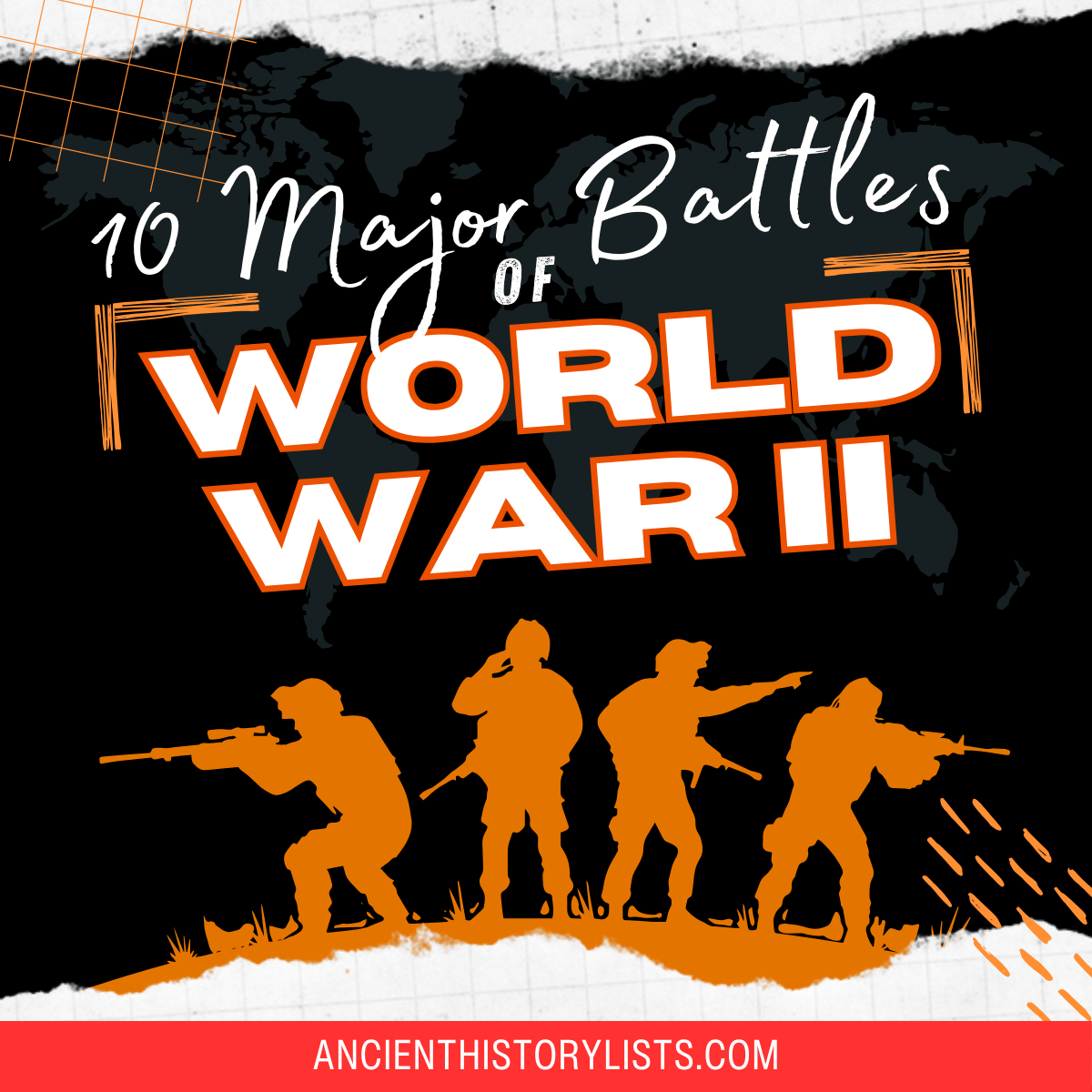
Here is a list of the 10 major battles fought during the Second World War:
10. Battle of Kursk, July to August 1943
The Battle of Kursk was fought during the Second World War from July to August 1943.
It was a series of offensives between the German and Soviet forces on the Eastern Front near Kursk, 450 kilometers southwest of Moscow.
Operation Citadel was the German codename for the offensive. It led to one of the largest ever armored clashes, the Battle of Prokhorovka, fought on July 12, 1943. The Battle of Kursk was an unsuccessful attempt by the Germans to take over the Soviet forces, and they lost a huge number of men and tanks in the process.
The Soviet line at Kursk was protruding into enemy territory and the Germans attempted to attack from different directions.
The Soviet forces held off the offensive and launched counterattacks called Operation Polkovodets Rumyantsev and Operation Kutuzov which helped reclaim the cities of Orel and Kharkov.
This was the first time during the war that a German strategic offensive was halted before it could break through enemy lines. The German advance was 8 to 12 kilometers in the north and 35 kilometers in the south.
9. Battle of Berlin, April to May 1945
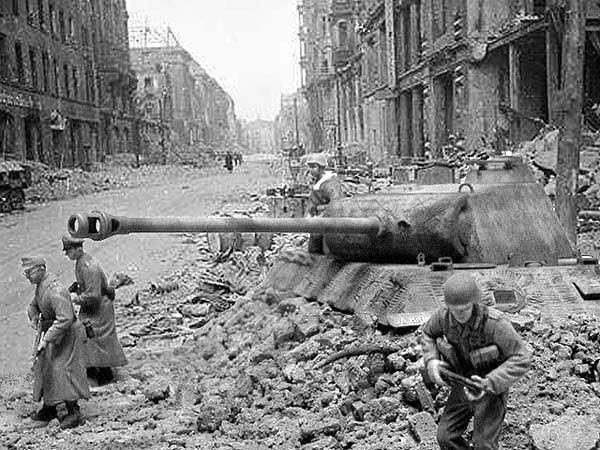
Also known as the Berlin Strategic Offensive Operation by the Soviet Union, the Battle of Berlin was the final major offensive of the Second World War in Europe.
After the Vistula-Oder Offensive of January–February 1945, the Red Army halted on a line 60 kilometers east of Berlin. Operation Clausewitz was the German defense plan against the Soviet attack.
After the Soviet offensive was resumed on April 16, the city was attacked from the east and south, and a third force countered the Germans in the north. A Soviet soldier described the enormous amount of equipment deployed during the attack.
The Soviet army was successful in encircling the city and on April 20, 1945, also Hitler’s birthday, the 1st Belorussian Front started shelling the city center, while the 1st Ukrainian Front advanced to the southern suburbs. Hitler and a number of his followers committed suicide before the battle was over.
The city surrendered on May 2 while fighting continued to the northwest, west and southwest of the city until May 8, when the war finally ended in Europe. After this battle, the city of Berlin was divided into four as agreed by the Allies.
8. Battle of Moscow, October 1941 to January 1942
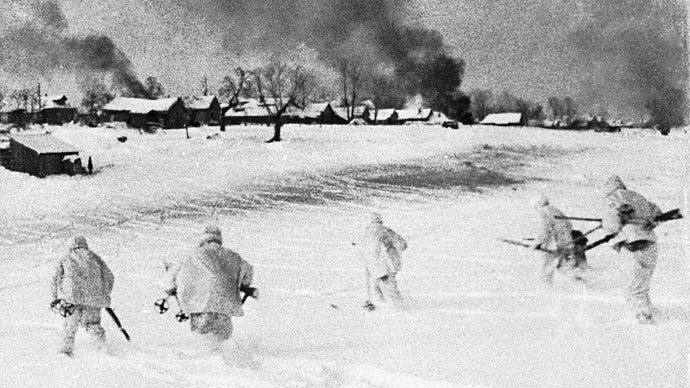
The Battle of Moscow represents two significant periods of fighting on the Eastern Front during the Second World War from October 1941 to January 1942.
By early October, after four million casualties on the Soviet side, the German army had come to within 200 miles of Moscow. This was when Operation Typhoon was launched, an offensive intended to seize the Soviet capital and put an end to the campaign. But the reality turned out to be far from what either side had expected.
The Soviets had a huge but badly organized army. The Germans, on the other hand, with their expertise and equipment could have won any war on the planet.
But due to the freezing weather and inability to get supplies through to the Panzer Army, the Soviet defense was able to hold off the Germans. The poor-quality Russian roads had taken out about 40 percent of the German truck fleet and by the time the Germans were within 15 miles (24 kilometers) of Moscow, they were battered and exhausted.
The Soviets defended the city by constructing three defensive belts, deploying new armies and bringing troops from the Siberian and Far Eastern Military Districts.
7. Second Battle of Kharkov, May 1942
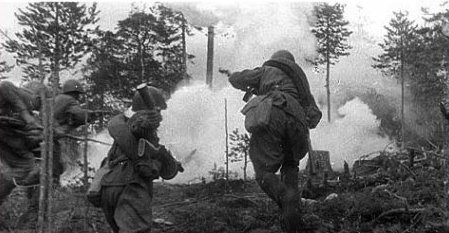
The Second Battle of Kharkov was fought from May 12 to 28, 1942.
It was an Axis counter-offensive in the region around Kharkov against the Red Army on the Eastern Front. The objective of the offensive was to eliminate the Izium bridgehead over Seversky Donets or the “Barvenkovo bulge,” an area known for staging Soviet offensives.
After the Battle of Moscow, which drove the German forces away from the Soviet capital, the Kharkov Offensive was a new attempt from the Soviet side to expand their strategic initiative.
On May 12, 1942, under the command of Marshal Semyon Timoshenko, the Soviet forces attacked the German 6th Army from a salient established during the winter counterattacks.
This offensive further depleted the Red Army’s reserves and failed to gain a significant element of surprise. Initially there were promising signs for the Red Army but the offensives were stopped by German counterattacks.
Joseph Stalin and several staff officers made critical errors in underestimating the 6th Army’s potential and overestimating their own forces. This cut off the advancing Soviet troops from the rest of the front. The battle led to almost 300,000 casualties on the Soviet side and 20,000 for the Germans and their allies.
6. Battle of Pearl Harbor, December 7, 1941
The devastating attack on the US naval base at Pearl Harbor in Hawaii by Operation AI of the Japanese Imperial Army, was a complete surprise and took place on December 7, 1941.
This attack marked a climax in the worsening relationship between Japan and the Unites States. Once the US fleet was out of their way, the road to conquering all of Southeast Asia and the Indonesian archipelago would open up for the Japanese.
On November 26, a Japanese fleet including six aircraft carriers, two battleships, three cruisers, and eleven destroyers sailed 275 miles north of Hawaii.
About 360 planes were launched from this point for the final assault. Four US Navy battleships were sunk and the remaining four were damaged. Additionally three cruisers, three destroyers, an anti-aircraft training ship and one minelayer were also sunk or damaged.
A total of 2,403 Americans died in the attack and 1,178 others were wounded. This surprise attack came as a shock to the American people and led to the US entering the Second World War in both Europe and the Pacific.
On December 8, the United States declared war on Japan.
5. Battle of France, May to June 1940
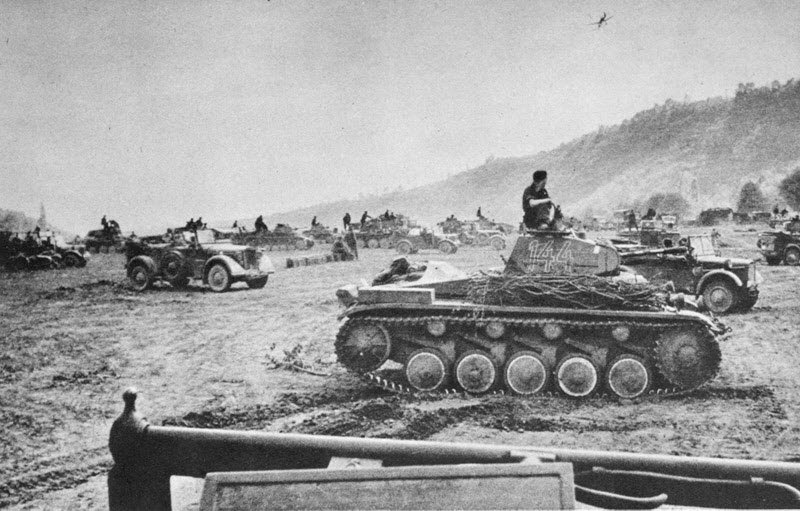
The German invasion of France and the Low Countries in 1940 is known as the Battle of France or the Fall of France.
In a short space of six weeks starting on May 10, 1940, the German forces defeated the Allies and conquered France, Belgium, Luxembourg, and the Netherlands. Italy also tried to invade France by entering the war on June 10, 1940. The land operations on the Western Front from the German side were all over by June 6, 1944.
The Battle of France saw two main operations on the German side. Fall Gelb (Case Yellow) saw the armored German units break through the Ardennes along the Somme Valley cutting off and surrounding the Allied units advancing to Belgium.
After the Belgian and French forces were driven back to the sea, the British evacuated their own troops and several French divisions from Dunkirk in Operation Dynamo.
After the British troops left, Fall Rot (Case Red) began on June 5. The remaining French divisions resisted but were soon overcome. Paris was occupied by German forces on June 14.
Following the battle, France was divided up and occupied by Germany, Italy, and the neutral Vichy government.
4. Battle of Britain, July to October 1940
After the fall of France, Hitler expected the British to seek a peace settlement with Germany, but Britain continued to fight.
To bring the war to a quick end Hitler planned an invasion of Britain, codenamed Operation Sealion. For the operation to be successful, the Germans had to first secure the skies over the United Kingdom which were protected by the Royal Air Force (RAF).
Germany had been banned from having an air force after the First World War but the Nazi government had reestablished it and it was one of the most formidable air forces in the world. The RAF fought the Germans off with the Hawker Hurricane and the Supermarine Spitfire, two of the best fighter aircraft in the world.
Unable to gain advantage over the RAF, the Germans shifted their focus to London. This would be a critical error by the Germans, because despite the devastation it caused to the residents of London, it also gave the British defenses time to recover.
On September 15, the British resisted another massive attack by the Germans who suffered many losses. Later, Hitler postponed Operation Sealion indefinitely. This victory was one of the most important for Britain and proof that air power alone could be used to win a major battle.
3. Battle of Midway, June 1942
The Japanese planned to eliminate the United States’ position as a strategic power in the Pacific by launching the Battle of Midway.
At the start of the battle, the Americans were outnumbered about 2 to 1. Between June 4 and 7, 1942, the Battle of Midway began with the US side commanded by Admirals Chester Nimitz, Frank Jack Fletcher, and Raymond A.
Spruance and the Imperial Japanese Navy under Admirals Isoroku Yamamoto, Chuichi Nagumo, and Nobutake Kondo. Largely due to developments in codebreaking, the US was able to predict the date and location of the attack, giving them the upper hand.
The Japanese plan was also a failure due to their incorrect assumptions about the American mindset. All of the four large Japanese aircraft carriers which were a part of the force that attacked Pearl Harbor were sunk while the US only lost the carrier Yorktown and a destroyer.
Six months after the attack on Pearl Harbor, the Americans had earned a decisive victory over the Japanese and gained an offensive position for the Allies. Military historian John Keegan called the Battle of Midway one of the most stunning and decisive moments in the history of naval warfare.
2. Battle of Normandy, June to August 1944
The Battle of Normandy was codenamed Operation Overlord. With Operation Overload, the Allies launched the largest amphibious invasion of Normandy to free German-occupied Western Europe during the Second World War.
Commonly known as D-Day, the operation was launched on June 6, 1944 with the Normandy landings. About 160,000 troops crossed the English Channel on the same day and over two million Allied troops had reached France by the end of August.
Special technology was developed to cope with the conditions on the Normandy beaches, including artificial ports known as “Mulberry harbors” and a series of specialized tanks called Hobart’s Funnies.
The Allies carried out a military deception plan called Operation Bodyguard in which electronic and visual misinformation tricked the Germans over the date and location of the main landings.
The Allies did not attain their objectives on the first day but gained substantial momentum and captured the port of Cherbourg on June 26 and the city of Caen on July 21. Operation Dragoon was launched to invade southern France followed by the liberation of Paris on August 25.
By August 30, 1944, the German forces had retreated across the Seine which marked the end of Operation Overlord.
1. Battle of Stalingrad, July 1942 to February 1943
Considered by many historians as the turning point of the Second World War, the Battle of Stalingrad was fought between July 1942 and February 1943.
The German army suffered many losses, after which it began its full retreat and the war turned in favor of the Allies. The Russians consider this battle to be the greatest of the Second World War, and it is also known as the Great Patriotic War in Russia.
The battle was devastating with nearly two million military and civilian casualties, one of the greatest losses in military history.
The German 6th Army was not required to fight the battle. Army groups A and B were already on their way to the Caucasus in southwest Russia to secure the oil fields there when Hitler ordered the attack on the city.
While it was generally unwise to leave a major city unconquered during an advance, some historians believe that it was mainly Hitler’s personal hatred of the Russian leader Stalin (whose name was part of the city’s identity) which led to the attack. For simple reasons of morale, the Russian army could not afford to lose the city.
Conclusion
Of all the battles fought during World War II, these were the most prominent and had a lasting impact on the final outcome. These offensives and assaults brought about millions of military and civilian casualties as some of the battles directly targeted cities like London, Stalingrad, and Moscow. Led by generals, admirals and commanders with tremendous strength on both sides, each battle’s successes and failures slowly paved the way for the final Allied victory in 1945.
I believe the Battle of the Bulge was more of a pivotal force as a possible turning point in the war than that of the Battle of Berlin. No matter how brutal the battle was, the Battle of Berlin had a for certain outcome of victory for the overwhelming Russian forces. Yet, the Battle of the Bulge had factors whereby the outcome was not certain and the alternate outcome would had proven devastating for the Allied efforts.
Before the Battle of the Bulge, the Germans were retreating and the AEF pushing east. After the Battle of the Bulge, the Germans were retreating and the AEF pushing east. It was in no way a turning point.
While the German offensive was initially successful, they were soon losing speed due to many reasons, one of them being that the terrain was well-suited for defense and the US troops, while they were forced to retreat a lot to begin with, very soon had made it impossible for the Germans to reach their goals. It can’t really be said that the outcome was uncertain.
Also, apart from getting a lot of generals sacked, even if the Germans had been able to achieve their goals it would not change the outcome. The Germans could never keep the Allies from cutting the force in Antwerp off from the rest of the German army, and a little while later the Germans would have to surrender.
Its sad that they didn’t even mention the Battle of El Alamein, in my opinion, the major turning point in the war, along with the Battle of Iwo Jima. This list is just wrong, and yes, the Battle of the Bulge was more important than the Battle of Berlin
More Russian soldiers died at Stalingrad than the entire war dead of the USA and UK combined. Any one who thinks that it was any country other than the soviet union that turned the war around is highly deluded. And before anyone calls me a raving leftie, my granpa died on the shores of Italy trying to free Europe. Thatcher used to paint a picture of handle bar moustache wearing English men who fought the battle of Britain, forgetting that pilots came from all over the UK, the commonwealth and Poland, France, Czechoslovakia and other countries.
80 percent of the pilots were British in the Battle of Britain, look it up. They flew from our Country and from the largest Empire the World has ever known. 80 percent!
How many Countries were helping you? A lot. How many different nationalities? A huge amount.
Wow. Soviet Union was not involved in the Pacific War so they only turned around the European Theatre. Ultimately that was only possible to the extent it was after Overlord was launched.
But yes, the Eastern Front and Stalingrad was a monumental effort. Sorry for your lost, my grandad did not die in WW2, but I have served on three military operations myself over 41 full time service as an infantryman, so I do know what I am talking about as much as anyone else
Cheers
JC
As was already mentioned, it is deluded point of view. 80% of all German losses was on the Eastern front. Importance of Pacific was nowhere close to what was going on in the East. Just look up Axis casualties for any of Eastern front battles there and compare to what was going on anywhere else.
Overlord happened when the fate of Nazis was decided. The was no question if Nazis would loose, the only question was when and how many more people will die.
P.S. To move all Eastern Front battles down the list… wow, what a hypocrisy! Where is Bagration? Battle of France? Seriously?
It’s hard to ignore the Battle of the Atlantic as among the most important. Churchill the U-Boat Peril as his greatest fear. Without victory in the Atlantic, D-Day would not have been possible.
I agree, the Battle of the Atlantic was pre-requisite and/or absolutely crucial to many of the top battles listed above. Supplies of troops and materials needed to cross the Atlantic from the Americas for The Allies to conduct the war. Were more U-boats available in 1939 Britain would have been starved of supplies before the United States could have entered. As it was, the Battle of the Atlantic was desperate for Britain and her allies in 1940-41. Even if the paltry number of ocean-capable boats had been efficiently supported by air reconnaissance, and new boats built in 1939-40 as Admiral Doenitz pressed for, it is unlikely the Battle of Britain, Soviet campaigns supported by sea via Murmansk, nor Mediterranean actions could have been successful for The Allies. The U-boat war deserves not just to be ranked among the 10 listed “more glamorous” battles, but in my view was THE most critical of WW2.
Totally agree, if Karl Donitz had his 300 U-boats in 1941 the war would have ended that year.
With the few U-boats the Kriegsmarine had in 1941-1942 the UK was desperately short of fuel supplies, we even had to use some of the Royal Navies strategic reserves for civilian use, not to mention the daily rations for civilians was not too generous.
If UK was knocked out of war in 41/42 then no invasion of Europe, no bombing of German war factories, and total concentration of Axis forces on Soviet Union, with no supplies going to Russia.
Might have been enough force to beat USSR????
As for America, Japan would have still bombed Pearl harbour and Germany would have still declared war on US.
So US would have been fighting Germany, Japan, Italy, Hungary, Romania and Finland all on its own with no friendly countries to use as a springboard to get to Axis forces.
The Soviet Summer offensive in 1944–Operation Bagration—was perhaps the most destructive German defeat in WW2, rivaled only by Stalingrad. It didn’t alter the course of the war so much as speed it up its inevitable end. So massive was the damage to the German military in the east that thereafter Hitler hadn’t even the slightest possibility of stopping or even delaying the Red Army juggernaut, which would roll on to the Rhine within a year unless the Allies could get across it first. They did, but barely. Had we been held up another two months, the Cold War would have been decidedly different with all of Germany a Stalinist German Democratic Republic.
The battles in the war that were most important were fought in the east. russia turned the war around and the allies took advantage of germanys weakened forces. usa, britain and other allied nations played their part in winning the war but it was the russians who surrounded and took berlin, not britain or the usa. so russia played the biggest part of winning the war, and the battles on russian soil were the most important. stalingrad and kursk were so vital to the outcome of the war. sadly too many people in britain and the usa think that those countries won the war on their own, how deluded can people be.
Totally right Sam. Even Churchill said it was the Russians that ‘tore the guts’ out of the German army.
It’s very obvious that someone has not studied the War in depth and in it’s entirety when they dismiss the absolutely massive role of the Soviet Union and how the Nazis fate was already sealed long before D-Day even took place… One could argue that the most crucial role America played in defeating the Nazis was with lend lease and their massive armament and supply shipments to the Soviet Union which helped allow them to decimate the Nazis… D-Day relieved pressure on the Soviet Union and guaranteed that Western Europe wouldn’t fall to the Russians but it likely was not necessary to ensure the Nazis defeat… The Western Air Bombardment was devastating but in no way was a war deciding factor… ~80%+ of German losses were on the East… Purposeful end of war surrenders where German and Axis troops intentionally retreated Westwards in order to surrender to Western Forces instead of Soviet Forces swells the number of those captured by the West but in reality these were not troops who were defeated in battle by Western Forces…
The Soviets lost 27 million defeating the Nazis (heck, they lost more in single battles than the entirety of losses suffered by Britian and America in the whole war) and they deserve the bulk of the credit for the it…
The Soviet Invasion of Manchuria and the total decimation of the Kwangtung Army was also a crucial factor leading to the Japanese surrender as they absolutely feared more than anything else of being invaded and occupied by the Russians…
Note on above regarding the last paragraph…
Obviously America had Japan on it’s knees and could have finished the war without any outside help however the Soviets entry and massive quick victories helped, along with the atomic bombings, to ensure that Japan itself would not need to be invaded and thus saved countless Allied lives…
Do you think the battle of Moscow would have had a different outcome if Japan had attacked the Soviet Union in the far east instead of attacking the USA at Pearl Harbor in early December 1941? By Gregg L. Friedman MD
Yes I do, in fact it probably would have changed the outcome of the war. If two forces had attacked Soviet Russia then likely the axis powers could have taken it, Russia was a true juggernaut just in sure forces, but they were distributed poorly early in war which could have proved a Japanese or German Victory. America would not likely have become involved in the war if the Japanese had not attacked Pearl Harbor. It was truly this decision that put Japan in a bad spot and made the axis powers weaker and not able to defend themselves. like the others have said Russia was a pivotal part of the war and they truly were powerful but it took time for them to prepare and if an early attack took place from two fronts I dont believe they would have stood a chance.
Oh if only the Japanese Army had gotten it’s way as opposed to the Navy… One of the biggest what if’s of WW2… Operation Barbarossa likely would have succeeded had the Soviet forces been split between two fronts and had Japan decided on the Army’s plan as opposed to the Navy’s Pearl Harbor would have never occurred and thus America’s entry never occur or occurs way further down the line in a drastically different scenario…
Had Britain lost the battle of Britain and therefore taken out of the war, The US may not of got involved in Europe, the German air force which lost more than 1/2 its planes in the west could have had a much bigger impact in the east along with all the anti air craft resources and industry spared bombing damage, and the massive but futile effort that went into the Atlantic war wouldnt have been expended. A straight up fight between the USSR and Germany would have been interesting.
The victories of the Battle of Britain and Battle of the Atlantic were the most important strategic achievements of WW2 as Britain and her allies, notably the maritime Dominions such as Newfoundland and Canada and the British Empire, fought on alone for four years before any substantial involvement by the Americans, who were decidedly anti-war, while most of Europe had surrendered to tyranny. Eventually the German effort shifted to the East. British Prime Minister Churchill rallied Stalin, having kept US President Roosevelt in the loop for years, as he arranged supplies to Russia through the ports in Murmansk and Archangel and with the help of South Africa through the Red Sea and via rail through Iran and northward. He kept Germany engaged in Britain, Italy and northern Africa, denying Germain access to Middle East oil supplies, while shipping trucks, aircraft and tanks to Russia, but most importantly food to the starving population, allowing her to build up her primitive army and defenses. Had the Germans captured Britain, and most importantly the world’s largest navy, the Royal Navy, the US eastern seaboard cities, shipyards and factories would have been defenseless against naval bombardment and with a small voluntary army of only 100,000 been helpless against attack. With the Germans, impaired by its depleted Luftwaffe, tied up with a now stronger, well supplied and no longer starving Russia, Britain was able to accommodate the Allied forces on her soil, to prepare for the European assault, drawing Germain forces from the East and resources required for its defense. This eased the way for the now fortified, better armed and better equipped Russian effort to prevail. British efforts to bolster the Chinese, engaging the Japanese on land, in the air and at sea in south-east Asia and the Pacific helped the Americans prevail in that theatre. Her experienced military leadership helped train the American general staff and her scientific innovation, including atomic research, outpaced the German and Jananese efforts by a wide margin. He inspired people the world over to have the courage to fight, to sacrifice, encouraging women to replace men in factories while still performing their all-important role of heads of families, and improved morale in the face of almost certain defeat. Ironically, he was voted out of office at the end of the war, after playing the most important role of any individual in modern history by bringing the free world together with the unity of purpose in defeating totalitarianism. The individual battles were all important but without that effort the world today would probably be unrecognizable.